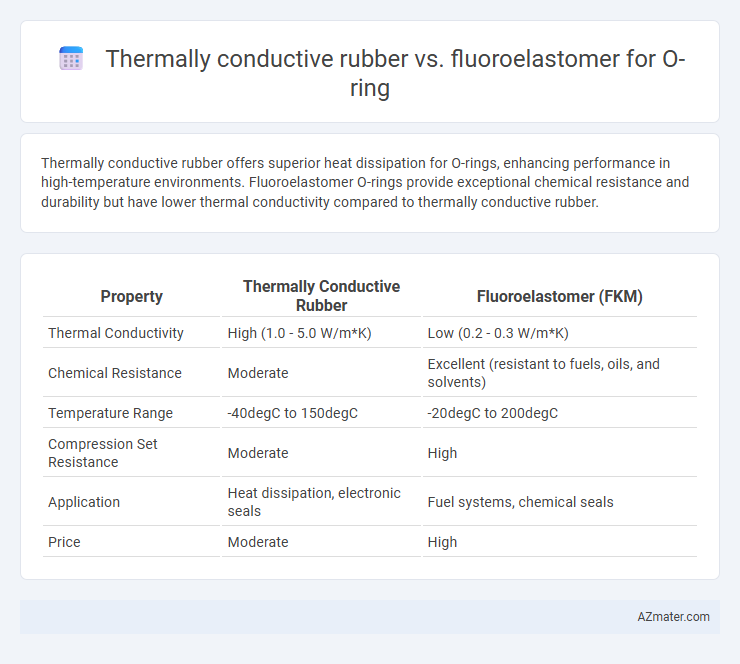Thermally conductive rubber offers superior heat dissipation for O-rings, enhancing performance in high-temperature environments. Fluoroelastomer O-rings provide exceptional chemical resistance and durability but have lower thermal conductivity compared to thermally conductive rubber.
Table of Comparison
| Property | Thermally Conductive Rubber | Fluoroelastomer (FKM) |
|---|---|---|
| Thermal Conductivity | High (1.0 - 5.0 W/m*K) | Low (0.2 - 0.3 W/m*K) |
| Chemical Resistance | Moderate | Excellent (resistant to fuels, oils, and solvents) |
| Temperature Range | -40degC to 150degC | -20degC to 200degC |
| Compression Set Resistance | Moderate | High |
| Application | Heat dissipation, electronic seals | Fuel systems, chemical seals |
| Price | Moderate | High |
Introduction to O-Ring Materials
Thermally conductive rubber offers efficient heat dissipation in O-ring applications, making it ideal for electronics and high-temperature environments where thermal management is crucial. Fluoroelastomer O-rings provide exceptional chemical resistance and durability, suitable for aggressive fluids and extreme conditions commonly found in automotive and aerospace industries. Selecting the correct O-ring material depends on balancing thermal conductivity needs against chemical compatibility and mechanical performance requirements.
Overview of Thermally Conductive Rubber
Thermally conductive rubber used for O-rings offers exceptional heat dissipation properties by incorporating fillers like boron nitride or aluminum oxide, enabling efficient thermal management in electronic and automotive applications. This material combines flexibility and resilience with enhanced thermal conductivity, typically ranging from 1 to 10 W/m*K, significantly outperforming standard elastomers such as fluoroelastomers that exhibit much lower thermal conductivity, usually below 0.5 W/m*K. Its ability to maintain sealing integrity under elevated temperatures and thermal cycling makes thermally conductive rubber ideal for scenarios demanding both mechanical sealing and heat transfer, unlike fluoroelastomers which excel more in chemical resistance and extreme temperature tolerance.
Key Characteristics of Fluoroelastomer
Fluoroelastomer O-rings exhibit exceptional chemical resistance, operating efficiently in temperatures ranging from -26degC to 204degC, making them ideal for harsh environments involving fuels, oils, and acids. Their low permeability and superior compression set resistance ensure long-lasting sealing performance under high pressure and dynamic conditions. Compared to thermally conductive rubber, fluoroelastomers offer enhanced stability and durability in aggressive chemical applications but typically have lower thermal conductivity.
Thermal Conductivity Comparison
Thermally conductive rubber O-rings exhibit significantly higher thermal conductivity values, often ranging from 1 to 10 W/m*K, compared to fluoroelastomer O-rings, which typically have thermal conductivity around 0.2 W/m*K. This higher thermal conductivity allows thermally conductive rubber O-rings to more effectively dissipate heat in high-temperature applications, reducing thermal stress and enhancing seal longevity. Fluoroelastomer O-rings, while chemically resistant and stable at elevated temperatures, offer limited heat transfer capabilities, making them less suitable for applications requiring rapid heat dissipation.
Chemical Resistance: Rubber vs Fluoroelastomer
Thermally conductive rubber offers moderate chemical resistance, suitable for general industrial applications but may degrade when exposed to strong acids, bases, or solvents. Fluoroelastomer O-rings exhibit superior chemical resistance, maintaining integrity against aggressive chemicals, fuels, oils, and high-temperature environments commonly found in automotive and aerospace industries. This makes fluoroelastomers the preferred choice for sealing solutions requiring long-term durability in harsh chemical conditions.
Durability and Mechanical Performance
Thermally conductive rubber O-rings offer enhanced heat dissipation and excellent wear resistance, maintaining mechanical integrity under high-temperature cycling and abrasive conditions. Fluoroelastomer O-rings excel in chemical resistance and retain flexibility at elevated temperatures, but may experience reduced tensile strength and wear resistance compared to thermally conductive rubber in abrasive environments. For applications demanding superior durability and mechanical performance under thermal stress and mechanical wear, thermally conductive rubber typically outperforms fluoroelastomer materials.
Application Suitability in Industry
Thermally conductive rubber O-rings excel in electronic and automotive industries due to their ability to dissipate heat, enhancing component reliability under high-temperature conditions. Fluoroelastomer O-rings, renowned for chemical resistance, are ideal for aerospace, chemical processing, and fuel systems with exposure to aggressive fluids and extreme temperatures. Selecting between these materials depends on the specific industry demands of thermal management versus chemical durability for optimal sealing performance.
Cost Analysis of Both Materials
Thermally conductive rubber O-rings generally have higher upfront costs due to specialized fillers like boron nitride or aluminum oxide that enhance heat dissipation. Fluoroelastomer O-rings, while typically less expensive initially, offer superior chemical resistance and temperature stability making them cost-effective for long-term applications in aggressive environments. Evaluating total cost of ownership involves balancing thermally conductive rubber's performance benefits against fluoroelastomer's durability and lower replacement frequency.
Installation and Maintenance Differences
Thermally conductive rubber O-rings offer improved heat dissipation, requiring careful installation to avoid damage due to their stiffer material compared to the more flexible fluoroelastomer O-rings, which allow for easier fitting in complex assemblies. Maintenance for thermally conductive rubber demands routine inspection for thermal degradation to maintain performance, while fluoroelastomer O-rings are more chemically resistant and require less frequent replacement in harsh chemical environments. Installation of fluoroelastomer O-rings is generally simpler due to their elasticity, but they may need more frequent monitoring in high-temperature applications compared to thermally conductive rubber counterparts.
Selecting the Right Material for Your O-Ring Needs
Thermally conductive rubber O-rings excel in heat dissipation, making them ideal for applications requiring efficient thermal management, such as electronics and automotive components. Fluoroelastomer O-rings offer outstanding chemical resistance and high-temperature stability, suitable for aggressive environments like fuel systems and chemical processing. Selecting the right material depends on prioritizing thermal conductivity for heat-sensitive applications or chemical resilience for exposure to harsh fluids and extreme temperatures.

Infographic: Thermally conductive rubber vs Fluoroelastomer for O-ring
 azmater.com
azmater.com